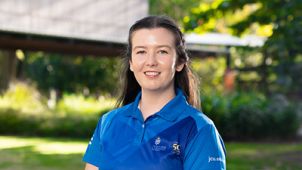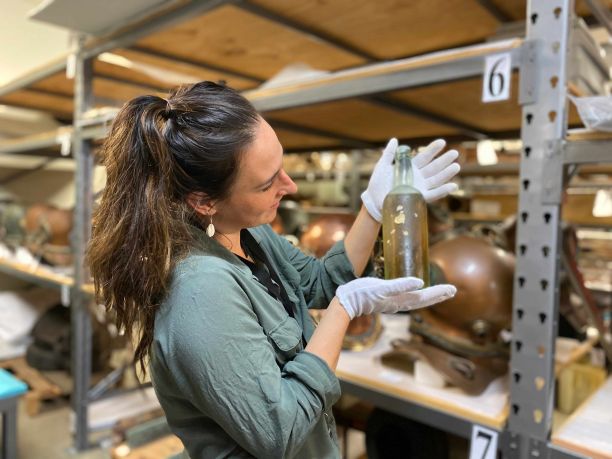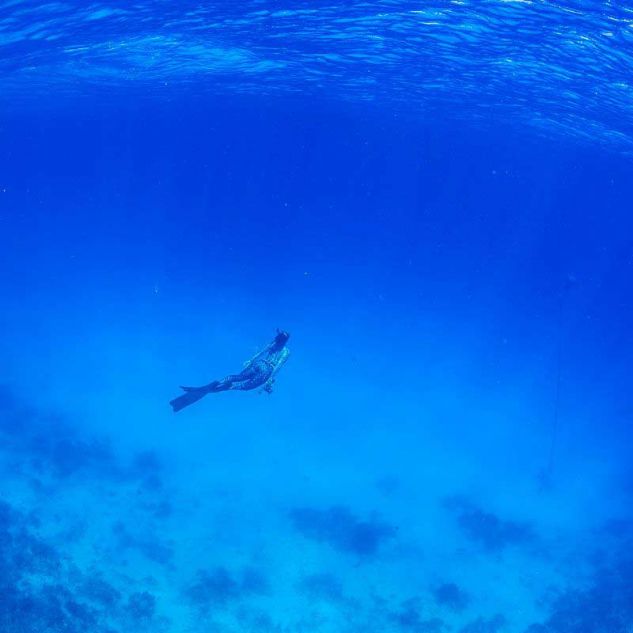
Written By
Tianna Killoran
College
College of Arts, Society and Education
Publish Date
30 March 2022
Related Study Areas
Science meets history
JCU maritime archaeologist and Senior Curator Dr Maddy McAllister is uncovering the mysteries of the reef and bringing shipwrecks to life for the wider public to enjoy. Maddy has a joint role with JCU and the Queensland Museum where she researches the Great Barrier Reef’s landscape of sunken ships. This Social Sciences Week (September 6 – 12), Maddy brings light to the perfect blend of science and history involved in her work.
Maddy says that growing up she loved scuba diving and being in the ocean, but she also loved to read about the past. So, how did she manage to combine these passions? “When I was about 13 or 14, my mum brought me along to a lecture by a museum curator and maritime archaeologist at the local RSL. I was probably the youngest person in the room! It was this curator who introduced me to the idea of studying shipwrecks,” Maddy says.
“It was through this that I discovered maritime archaeology’s wonderful mix of being underwater but also studying history and learning new things about our past through the study of shipwrecks.” Maddy says.
“So, after completing my PhD and working in Melbourne as a state maritime archaeologist, I came to work in Townsville in a joint role between JCU and the Queensland Museum. I work as a Senior Curator located at the Museum of Tropical Queensland and I also get to research and teach at JCU one day a week.”
Maddy’s passion for maritime archaeology highlights the strength of social sciences research. “I think social sciences is the perfect bridge between arts and sciences and that’s where disciplines like maritime archaeology really thrive. You can do really technical and scientific research, but also bring in people’s stories with the historical and archaeological research; it helps us to understand more about our past and look to the future,” she says.
Mysteries of the reef
One of her current research projects that Maddy is excited about investigates mystery shipwrecks scattered around the Great Barrier Reef.
“A lot of people are most familiar with some of the famous shipwrecks like the HMS Pandora and the SS Yongala, but there’s also about 900 other known wrecks around the reef, including both ships and aircraft,” Maddy says.
But the problem is that we don’t always know where the shipwrecks are located. Even when one is found, how do we know what ship it is?
“I investigate the archaeological clues left behind by these wrecks, which is often little bits and pieces of the ship that I combine with historical and archaeological research.”
JCU Researcher Dr Maddy McAllister, Senior Curator, Maritime Archaeology
Maddy says the small shipwreck clues can be many different things and require knowledge of archaeological, scientific, and historical research methods. “We take samples from wood — if there’s anything left to identify — and the types of wood can tell you a lot about the ship. For example, ships built in Europe and the United Kingdom were often built with oak that we can trace back to the forests there.
“We can also now sample the copper-alloy fasteners, which are usually bronze and brass on the ship, and they can help us to date the ships based on the composition of those items,” she says. “There’s also a lot of information that can be tracked down through ship logs and journals, which combined with newspaper reports and facts about the ships’ structure, can help you to narrow down which ship was wrecked in which location.
“It’s like a cold case that you have to solve by putting together all of the little pieces of the historical and archaeological puzzle. With that information you can hopefully identify the shipwreck,” she says.


Shipwrecks brought to life
Not everyone is a seasoned scuba diver, so Maddy works to make the experience of these shipwrecks available to the wider public. Maddy makes use of 3D modeling and creates a variety of digital outputs to help people experience the shipwrecks from the museum.
Maddy completed her PhD research on 3D image modelling of shipwrecks and says it is a useful technology for both archaeologists and members of the public. “I used the 3D image modelling to help us record a shipwreck site more quickly and efficiently. Often these places aren’t in very accessible waters and are usually on a reef so it can be difficult to spend a lot of time on that site to record all the details,” Maddy says.
“So, 3D modelling is a way to help archaeologists record a site quickly and accurately, and also a way to communicate those sites to the public in a really eye-catching and engaging medium,” Maddy says.
“More and more now we’re finding that we can have really great digital outputs in exhibitions that combine new technology with all of our past research,” Maddy says. “Hopefully we will be able to do that for the HMS Pandora where we can combine nine seasons of excavation data from the 1980s and 1990s with other maps and plans of the ship. We can also return to the site of the wreck and produce a 3D model. It will create a really great exhibition output and maybe even something that can be hosted online.”
Maddy says she loves diving into history and understanding more about our past as she swims among many disciplines. “I love that my job is exciting and that I get to be out in the field and dive, but I am also a real book nerd and get to spend a lot of time in archives. You can really dig deep into understanding peoples’ lives and how they lived on ships as well.”
Want to know more about Maddy's research that solves the mysteries of the deep? Find out about her latest adventures.

Featured researcher
Dr Maddy McAllister
Senior Curator, Maritime Archaeology
Maddy McAllister is the Senior Curator of Maritime Archaeology at the Queensland Museum Network, based at the Museum of Tropical Queensland campus in Townsville. Her position is co-appointed with the College of Arts, Society and Education at James Cook University.
Her research focuses on 18th to 20th century ship construction and investigates unidentified shipwrecks on the Great Barrier Reef. In addition, Maddy is passionate about public outreach and communication — firmly believing that we do this work for the public. Maddy has worked on numerous projects including American whale ships, the Maritime Archaeological Survey of Oman and the Shipwrecks of the Roaring Forties ARC Linkage-Project.